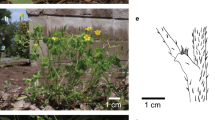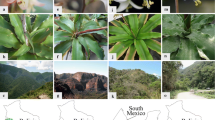Abstract
Hybridization between two diploid (2n = 2x = 16) species ofBrassicaceae, Cardamine rivularis andC. amara, at Urnerboden, Central Switzerland, resulted in the rather unusual triploid hybridC. insueta (2n = 3x = 24), and later on in the amphiploidC. schulzii (2n = 6x = 48). The hybrid and the neopolyploid species colonized successfully some man-made biotopes. Plants ofC. insueta are mostly functional females with non-dehiscent anthers, but true hermaphrodite individuals with partly sterile pollen grains also occur within the population. Analyses of cpDNA and nuclear DNA permitted to establish the parentage of the hybrid: the maternal parent which contributed unreduced egg cells proved to beC. rivularis whereas the normally reduced pollen originated fromC. amara. The pronounced genetic variability inC. insueta revealed by isozyme and RAPD analyses, at variance with the polarized segregation, heterogamy and strong vegetative reproduction of the hybrid, is possibly influenced by recurrent formation ofC. insueta which party results from backcrosses betweenC. insueta andC. rivularis but may also proceed by other pathways. The amphiploidCardamine schulzii has normally developed anthers but its pollen is sometimes highly sterile. The surprisingly uniform genetic make-up of the new amphiploid species might be related to its possible monotopic origin and/or young phylogenetic age but should be further assessed. Site management seems to be very important to a further development of hybridogenous populations and their parent species. In conclusion, the evolution at Urnerboden is discussed in the context of the traditional concept of multiple plant origins.
Similar content being viewed by others
References
Bartelheim, S., 1996: Biosystematische Untersuchungen imCardamine pratensis-Komplex (Brassicaceae) und verwandten Arten. Rubisco- und Isoenzymanalysen. — Unpublished Ph.D. Thesis, University of Osnabrück.
Brochmann, C., Soltis, D. E., Soltis, P. S., 1992: Electrophoretic relationships and phylogeny of Nordic polyploids inDraba (Brassicaeae). — Pl. Syst. Evol.182: 35–70.
Cleland, R. E., 1972:Oenothera: cytogenetics and evolution. — New York: Academic Press.
Crawford, D. J., Smith, E. B., 1984: Allozyme divergence and intraspecific variation inCoreopsis grandiflora (Compositae). — Syst. Bot.9: 219–225.
de Vries, H., Boedjin, H., 1924: Die Gruppierung der Mutanten vonOenothera Lamarckiana. — Ber. Deutsch. Bot. Ges.42: 174–178.
Doyle, J. J., Doyle, J. L., 1987: A rapid DNA isolation procedure for small quantities of fresh leaf tissue. — Phytochem. Bull.19: 11–15.
—, —, —, —, 1990: Multiple origins of polyploids in theGlycine tabacina complex inferred from chloroplast DNA polymorphism. — Proc. Natl. Acad. Sci. USA87: 714–717.
Emerson, S., 1935: The genetic nature ofDe Vries' mutation inOenothera Lamarckiana. — Amer. Naturalist69: 545–559.
Erickson, L. R., Straus, N. A., Beversdorf, W. B., 1983: Restriction patterns reveal origins of chloroplast genomes inBrassica amphidiploids. — Theor. Appl. Genet.65: 201–206.
Fagerlind, F., 1940: Sind diecanina-Rosen agamospermische Bastarde? — Svensk Bot. Tidskr.34: 334–354.
Hurka, H., Düring, S., 1994: Genetic control of plastidic L-glutamate dehydrogenase isozymes in the genusCapsella (Brassicaceae). — Heredity72: 126–131.
—, 1989: Aspartate aminotransferase isozymes in the genusCapsella (Brassicaceae). Subcellular location, gene duplication and polymorphism. — Biochem. Genet.27: 77–90.
Knox, R. B., 1987: Pollen differentiation patterns and male function. — InUrbanska, K. M., (Ed.): Differentiation patterns in higher plants, pp. 33–51. — London: Academic Press.
Landolt, E., 1984: Über die Artengruppe derCardamine pratensis L. in der Schweiz. — Diss. Bot.72: 481–497.
Marhold, K., 1991:Cardamine amara L. in the Slovakian and Polish Carpathians. — Veröff. Geobot. Inst. ETH, Stiftung Rübel, Zürich106: 273–281.
—, 1994: Chromosome numbers of the genusCardamine L. (Cruciferae) in the Carpathians and in Pannonia. — Phyton (Horn, Austria)34: 19–33.
—, 1994: Typification of the names of two species ofCardamine pratensis group (Brassicaceae). — Taxon43: 77–83.
Morita, T., Sterk, A. A., den Nijs, J. C. M., 1990: The significance of agamospermous triploid pollen donors in the sexual relationships between diploids and tetraploids inTaraxacum (Compositae). — Pl. Spec. Biol.5: 167–176.
Mulligan, G. A., Moore, R. J., 1961: Natural selection among hybrids betweenCarduus acanthoides andC. nutans in Ontario. — Canad. J. Bot.39: 269–279.
Mummenhoff, K., Hurka, H., 1995: Allopolyploid origin ofArabidopsis suecica (Fries)Norrlin: evidence from chloroplast and nuclear genome markers. — Bot. Acta108: 449–456.
—, 1994: Chloroplast DNA restriction site variation and phylogenetic relation-ships in the genusThlaspi sensu lato (Brassicaceae). — Syst. Bot.19: 73–88.
—, 1995: Systematic implications of chloroplast DNA variation inLepidium sectionsCardamon, Lepiocardamon andLepia (Brassicaceae). — Pl. Syst. Evol.196: 75–88.
Neuffer, B., Jahncke, P., 1997: RAPD analyses of hybridization events inCardamine (Brassicaceae). — J. Pl. Ecol. Syst. (in press).
Ownbey, M., 1950: Natural hybridization and amphiploidy in the genusTragopogon. — Amer. J. Bot.37: 487–499.
Palmer, J. D., 1987: Chloroplast DNA evolution and biosystematic uses of chloroplast DNA variation. — Amer. Naturalist130: 6–29.
Schüpp, M., 1960: Klimatologie der Schweiz, C. Lufttemperatur. — Beiheft Ann. Schweiz. Meteorolog. ZA1959.
Smith-White, S., 1948: Polarized segregation in the pollen mother cells of a stable triploid. — Heredity2: 119–129.
—, 1955: The life history and genetic system ofLeucopogon juniperinus. — Heredity9: 79–91.
—, 1959: Pollen development patterns in theEpacridaceae. — Proc. Linn. Soc. New South-Wales84: 8–35.
Soltis, D. E., Soltis, P. S., 1989: Allopolyploid speciation inTragopogon: insights from chloroplast DNA. — Amer. J. Bot.76: 1119–1124.
—, 1990: Chloroplast DNA and nuclear rDNA variation: insights into autopolyploid and allopolyploid evolution. — InKawano, S., (Ed.): Biological approaches and evolutionary trends in plants, pp. 97–117. — London: Academic Press.
Stace, C. A., 1975: Hybridization and the flora of the British Isles. — London: Academic Press.
Taeckholm, G., 1922: Zytologische Studien über die GattungRosa. — Acta Horti Berg.7: 97–381.
Urbanska, K. M., 1977a: Reproduction in natural triploid hybrids (2n = 24) betweenCardamine rivularis Schur andC. amara L. — Ber. Geobot. Inst. ETH, Stiftung Rübel, Zürich44: 42–85.
—, 1977b: An autoallohexaploid inCardamine L., new to the Swiss flora. — Ber. Geobot. Inst. ETH, Stiftung Rübel, Zürich44: 86–103.
—, 1978: Ségrégation polarisée chez les hybrides naturels triploides (2n = 24) entreCardamine rivularis Schur etC. amara L. — Bull. Soc. Bot. France. Actual. Bot.1–2: 91–93.
- 1979: Reproductive strategies in a hybridogenous population ofCardamine L. — Proc. Int. Symp. Repr. Flow. Pl. Christchurch, p. 46.
—, 1980: Reproductive strategies in a hybridogenous population ofCardamine L. — Oecol. Pl.1: 137–150.
—, 1987: Disturbance, hybridization and hybrid speciation. — Invan Andel, J., Bakker, J. P., Snaydon, R. W., (Eds): Disturbance in grasslands, pp. 285–301. — Dordrecht: Junk.
—, 1989: Reproductive effort or reproductive offer? A revised approach to reproductive strategies of flowering plants. — Bot. Helv.99: 49–63.
—, 1990: Biology of asexually reproducing plants. — InKawano, S., (Ed.): Biological approaches and evolutionary trends in plants, pp. 273–292. — London: Academic Press.
—, 1994: Pollen, mating and paternity in agamospermous angiosperms. — Pl. Spec. Biol.9: 57–67.
—, 1972: Natürliche Bastarde zwischenCardamine amara L. undC. rivularis Schur aus den Schweizer Alpen. — Ber. Geobot. Inst. ETH, Stiftung Rübel, Zürich41: 88–101.
—, —, 1974: Biosystematic investigations inCardamine pratensis L. s. l. I. Diploid taxa from Central Europe and their fertility relationships. — Ber. Geobot. Inst. ETH, Stiftung Rübel, Zürich42: 42–139.
—, —, 1974b: Hybridation naturelle entreCardamine rivularis Schur etC. amara L., ses aspects cytologiques et écologiques. — Acta Soc. Helv. Sci. Nat.1974: 89–90.
—, —, 1978: Recherches démographiques et écologiques sur une population hybridogène deCardamine L. — Ber. Geobot. Inst. ETH, Stiftung Rübel, Zürich45: 30–53.
Uttinger, H., 1965: Klimatologie der Schweiz. E. Niederschlag. — Beiheft Ann. Schweiz. Meteorol. ZA1964.
Warwick, S. I., Bain, J. F., Wheatcroft, R., Thompson, B. K., 1989: Hybridization and introgression inCarduus nutans andC. acanthoides, reexamined. — Syst. Bot.14: 476–494.
Wendel, J. F., 1989: New world tetraploid cottons contain Old World cytoplasm. — Proc. Natl. Acad. Sci. USA86: 4132–4136.
Wyatt, R., Odrzykoski, I. K., Stoneburger, A., 1988: Allopolyploidy in bryophytes: Recurring origins ofPlagiomnium medium. — Proc. Natl. Acad. Sci. USA85: 5601–5604.
Zimmerli, S., 1984: The influence of management upon the development and the structure of theCardamine populations at Urnerboden. — Ber. Geobot. Inst. ETH, Stiftung Rübel, Zürich51: 38.
—, 1986: Einfluss der Bewirtschaftung auf die Entstehung und Struktur derCardamine-Populationen auf dem Urnerboden. — Veröff. Geobot. Inst. ETH, Stiftung Rübel, Zürich87: 141–154.
Author information
Authors and Affiliations
Rights and permissions
About this article
Cite this article
Urbanska, K.M., Hurka, H., Landolt, E. et al. Hybridization and evolution inCardamine (Brassicaceae) at Urnerboden, Central Switzerland: Biosystematic and molecular evidence. Pl Syst Evol 204, 233–256 (1997). https://doi.org/10.1007/BF00989208
Received:
Revised:
Accepted:
Issue Date:
DOI: https://doi.org/10.1007/BF00989208




